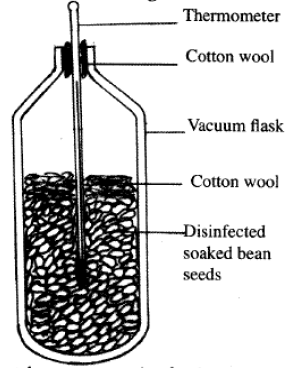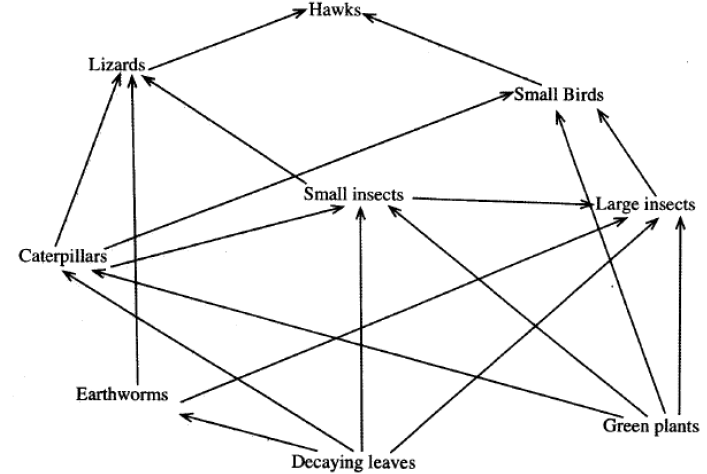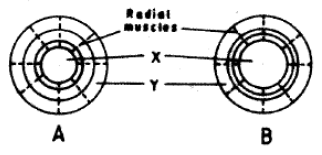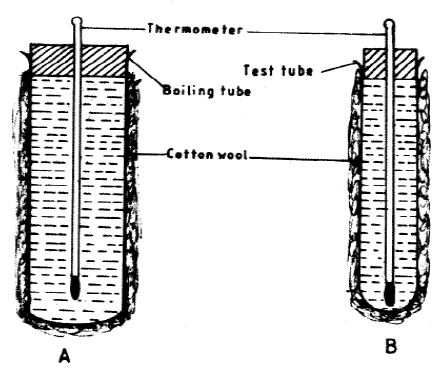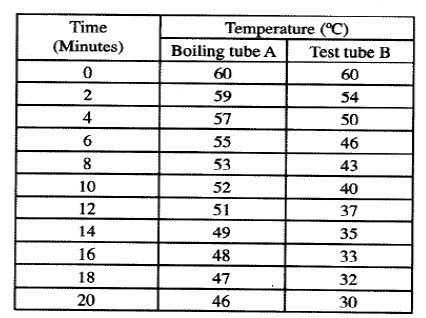QUESTIONS
SECTION A
Answer ALL the questions in this section in the spaces provided.
- In an experiment, disinfected soaked beans were put in a vacuum flask which was fitted with a thermometer as show in the diagram below.
The temperature readings were taken every morning for three consecutive days.- Which condition was being investigated? (1 mark)
- What was the expected results? (1 mark)
- Account for the answer in (b)(i) above. (2 marks)
- Why were the seeds disinfected? (2 marks)
- Why was the vacuum flask used in the set-up? (1 mark)
- How would a control for this experiment be set? (1 mark)
- Which condition was being investigated? (1 mark)
- The diagram below shows blood circulation in the in a mammal tissue.
- Name the part labeled P and Q. (2 marks)
- Name the substances that are:
- Required for respiration that move out of the capillaries; (1 mark)
- Removed from the tissues cells as a result of respiration. (1 mark)
- Explain how substances move from blood capillaries into the tissue cells. (3 marks)
- Name one component of the blood that is not found in the part labeled P. (1 mark)
- Name the part labeled P and Q. (2 marks)
- The diagram below represents a food web in a certain ecosystem.
- Name the tropic level occupied by each of the following:
- Caterpillars; ( 1 mark)
- Small insects. (1 mark)
- From the food web construct two food chains which end with lizards as the tertiary consumer. (2 marks)
- Which organisms have the least biomass in this ecosystem? (1 mark)
- Explain your answer in (c) (i) above. (3 marks)
- Name the tropic level occupied by each of the following:
- The diagram below shows how the iris and the pupil of a human eye appear under different conditions.
- Name the structures labeled X and Y. (2 marks)
- State the condition that leads to the change in appearance as shown in the diagram labelled B. (1 mark)
- Describe the changes that lead to the appearance of the iris and the pupil as shown in the diagram labeled B.
- What is the significance of the changes described in (b) (iii) above? (1 mark)
- State the condition that leads to the change in appearance as shown in the diagram labelled B. (1 mark)
- Name the structures labeled X and Y. (2 marks)
- When pure breeding black guinea pigs were crossed with pure breeding with pure breeding white guinea pigs, the offsprings had a coat with black and white patches.
- Using letter G to represent the gene for black coat colour and letter H for white coat colour, workout the genotypic ratio of F2. (5 marks)
- State the phenotypic ratio of F2. (1mark)
- Name the term used when two alleles in heterozygous state are fully expressed phenotypically in an organism. (1 mark)
- Give an example of a trait in human beings where the condition whose term is named in (c) (i) above expresses itself. (1 mark)
SECTION B (40 marks)
Answer question 6 (compulsory) and either question 7 or 8 in the spaces provided after question 8.
- Using letter G to represent the gene for black coat colour and letter H for white coat colour, workout the genotypic ratio of F2. (5 marks)
- In the experiment to investigate a certain physiological process, a boiling tube labeled A and a test tube labeled B were covered with cotton wool. The two tubes were simultaneously filled with hot water and fitted with thermometers. The experimental set-up was in the diagrams below.
Temperature readings were taken at the start after every two minutes for twenty minutes. The results were as shown in the table.- Using the same axes, draw graphs of temperature against time. (6 marks)
- Work out the rate of heat loss in the boiling tube labeled A and test tube labelled B between the 5th and 15th minutes. (4 marks)
- Account for the answers in (b) (i) above. (2 marks)
- How does the explanation in (b) (ii) above apply to the elephant and the rat? (2 marks)
- Work out the rate of heat loss in the boiling tube labeled A and test tube labelled B between the 5th and 15th minutes. (4 marks)
- State the role of the cotton wool in the experiment. (1 mark)
- Name two structures in mammals that play the role stated in (c) (i) above. (2 marks)
- State three advantages of having constant body temperature in mammals. (3 marks)
- Using the same axes, draw graphs of temperature against time. (6 marks)
- Describe the process of fertilization in flowering plants. (20 marks)
- Describe how a finned fish as Tilapia moves in water. (20 marks)

MARKING SCHEME
-
- Respiration (Rej: external respiration/ anaerobic respiration )
Acc: aerobic respiration. -
- Rise/ increase in thermometer / temperature reading.
- stored starch/ glucose/ carbohydrates in germination seeds are broken down/ oxidized to get energy. Some of the energy is released to get energy; some of the energy is released as heat.
- To kill bacteria/ fungi/ micro-organisms; that would cause decay/ decomposition / respire. (of the bean).
- To conserve heat/prevent heat loss to surrounding
- Use similar set up with dead disinfected seed.
Use dead disinfected bean seed/ use of dry bean seeds; acc formaldehyde / formalin for disinfection sodium hypochlorite.
- Respiration (Rej: external respiration/ anaerobic respiration )
-
- P – tissue fluid / intercellular fluid/ space.
Q – Venule. -
- Glucose, oxygen; Rej: formulae
- Carbon (IV) oxide, water; Rej; carbon dioxide OR Formula.
- Blood entering the arteriole has a higher pressure; than that leaving the venule, the pressure force water and small solutes (molecules) in blood to go through capillary wall forming tissue fluid; Nutrients / oxygen in tissue fluid move into the tissue cells by diffusion; Acc. Nutrients like glucose/ mineral salts/ vitamins/ fatty acids & glycerol. ( Acc 2 nutrients)
- Red blood cells/ proteins/platelets; Acc one example of protein e.g. globalin.
- P – tissue fluid / intercellular fluid/ space.
-
-
- Primary consumer
- Primary consumer / Secondary consumers;
- Green plants → Caterpillars → Small insects → lizard
Decaying leaves → Caterpillars → Small insects → lizard -
- Hawks;
- At each trophic level energy is lost as heat / respiration; and during decomposition; or lost in defecation/ feces/ waste products of metabolism/ excretion; some parts of the organism are not eaten; (hence less biomass as one moves up the tropic levels.
-
-
- X – pupil
Y – circular muscues -
- Dimlight / low light intensity/ darkness/ dull light.
- Circular muscles in (iris) relax; while radial muscle contract; the pupil becomes bigger allowing more light to enter the eye.
- allow one to visualize/ see objects under dim light;
- X – pupil
-
-
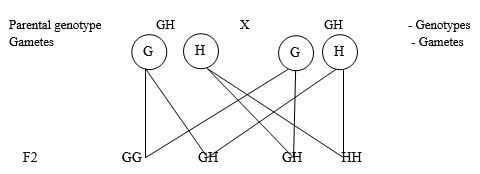
Genotypic ratio GG: GH: HH = 1:2:1;
Punnet Square
Parental genotype GH x GH NB: use of difference letter away 1mark for fusion lines only.
- Black : Black & white : White = 1: 2 : 1
-
- Codominance; (Rej: incomplete dominance, partial dominance, equal dominance, blending inheritance.
- ABO blood group inheritance. Acc. Blood group(Rej; Rhesus factor sickle cells trait.
-
-
-
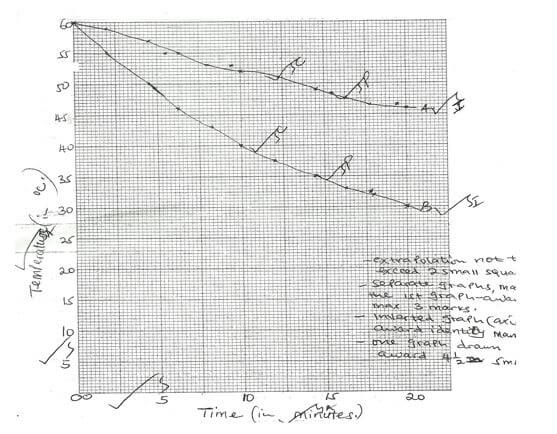
-
- A 56 - 48.5 = 7.5 = 0.75 + - 0.05 per minute.
15 – 5 10
B 48 - 34 = 14 = 1.4 + - 0.05 per minute.
15 - 5 10 - B has a large surface area to volume ratio making it to lose heat to the to the surrounding faster; Acc the converse/ viceversa.
- A rat has a larger surface area to volume ratio compared to an elephant; making the rate to lose heat at a faster rate than an elephant; Acc: the converse/ Viceversa.
- A 56 - 48.5 = 7.5 = 0.75 + - 0.05 per minute.
-
- Insulate against heat loss (to surrounding)
- Subcutaneous fat (layer) / Adipose tissue/ Bludder; fur/ hair; Rej: wool.
- Are active always( even under very cold conditions);
Able to escape from predators/ search for food/ mates ( because they are active always)
Can survive in (any habitat) both cold & hot habitat / wide range of habitats.
-
- Pollen grains land onto the stigma and adhere to it as a result of the stigma cells secreting a sticky substance . it absorbs nutrients; & germinates forming a pollen tube; the pollen tube grows down the style to the ovary; deriving nourishment from surrounding tissue. The pollen tube has tube nucleus at the tip; and generation nucleus immediately behind it; As the tube grows downwards into the ovary the generative nucleus divided 9by mitosis) mitotically, to give rise to two nucleui; which represent the male gametes; the pollen tube penetrate the ovule/ embryo sac/ chalaza through micropyle. After the pollen tube enters the embryo sac the tube nucleus breakdown/ disintegrates/degenerates; leaving a clear passage for the entry of the male nuclei. The (two male) nuclei then enter into the embryo sac; where one fuses with the egg cell nucleus (Acc; egg cell/ ovum/ oosphere, to form a diploid zygote; which develop into an embryo. The other male nuclei fuse with the two / both polar nuclei; to form atriploid nucleus/ primary endosperm nucleus; which becomes the endosperm. This (type of fertilization) is called double fertilization; Acc vegetative nucleus for tube nucleus.
- Movement of fish in water is by swimming. It involves forward movement and control of the body position in water. Mucus / streamline body shape reduces friction/ resistance (Acc; scale overlapping backwards) to enhance forward movement; forward movement/ propulsion is caused by the tail. The tail is long (almost half the large of the body of the fish) to enable it create enough force(to enable the fish push forward). Propulsion is achieved when the tail pushes sideways against water. Sideways movement is brought about by muscles arranged in segmented blocks/ myotomes on both sides of vertebrate column to swing sideways; when the muscle blocks on the right relax and those on the left contract; the body bends to the left side. When the muscle of the left relax and those on the right contract; the body bends to the right side; the fish uses its fins to control the position of body in water. During forward movement paired fin/ pectoral & pelvic fins). Lie flat on the body surface to reduce friction/ resistance. To change direction the fish uses the paired fins. Paired fins also are used by fish to change its level in water / control pitching. The fish spreads out the pectoral & pelvic fins at 900 to the body; to enable it brake. Fish can also use the swim bladder to change its level in water. When the bladder fills up with air the fish become less dense / lighter making it to rise in water; when the air leaves the bladder the fish becomes more dense/ heavier; making it to sink deeper in the water. Water currents may cause sideways swaying of the body of the fish/ yawing. The dorsal and ventral fins (also) prevent rolling / yawing; Acc anal fin for ventral fin.
Join our whatsapp group for latest updates
Tap Here to Download for 50/-
Get on WhatsApp for 50/-
Download KCSE 2010 Biology Paper 2 Questions with Marking Scheme.
Tap Here to Download for 50/-
Get on WhatsApp for 50/-
Why download?
- ✔ To read offline at any time.
- ✔ To Print at your convenience
- ✔ Share Easily with Friends / Students

